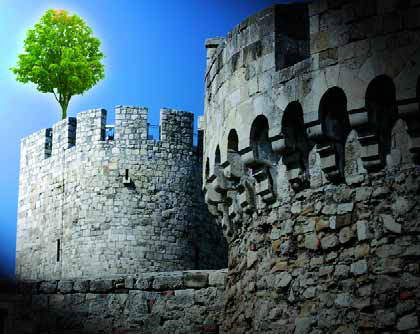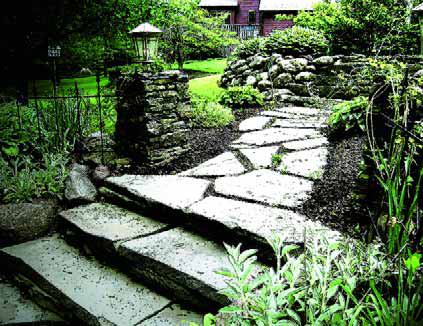On the Level
Early in the history of garden design – dating back to the earliest days of civilization in Sumeria, Egypt and China – plants took center stage in garden spaces. Terraces and hanging gardens were built not for their innate ornamental qualities, but rather to display the plants they contained. Always, the prized plant was more important than its container. This preeminence of plant displays has been the rule rather than the exception throughout history, even
I recently read a short article in a construction magazine in which the writer described a fairly convoluted process by which he had “protected” a tree on the site where he was working. Basically, what he did was wrap the trunk in two-by-four studs, securing them in place vertically with some loops of metal strapping. In his estimation, this was just what he needed to keep the tree from being damaged by accidental equipment bumps – the boards, in effect, would suffer and the tree
Last month, I introduced my rundown on books I like to have at hand in my studio by mentioning a project that included a pool, an outdoor kitchen, stone walls, a fire pit and some other amenities. A feature I didn't mention - but one that may well be unique for a backyard in upstate New York - was the Peruvian Travertine we chose for use around the pool. While decking material seldom takes center stage in a design, its high visibility tends to make it more than just a bit player. Indeed, the choice of a material can either
Last month, I introduced my rundown on books I like to have at hand in my studio by mentioning a project that included a pool, an outdoor kitchen, stone walls, a fire pit and some other amenities. A feature I didn't mention - but one that may well be unique for a backyard in upstate New York - was the Peruvian Travertine we chose for use around the pool. While decking material seldom takes center stage in a design, its high visibility tends to make it more than just a bit player. Indeed, the choice of a material can either
I recently began work on a design for clients who live in a historic home just south of Rochester, N.Y. They've asked me to incorporate a pool, entertainment areas, a fireplace and a combined pool house/garage into the available space and make certain it all complements the architecture of the home and its only current outbuilding - a 150-year-old storage shed. Sitting at my drafting table, I was thinking how easy this one would be, conceptually at least. All I needed was there, from the home's architecture and an existing (and much beloved) 100-year-old pergola to the old shed, so the main challenge would come in drawing the details rather than in deciding what to do. Usually, of course, it's the other way around and
Reading WaterShapes' 100th issue brought back memories of when I first discovered the magazine and my early conversations with its editor, Eric Herman. I remember thinking at that time - or at least hoping - that there really were lots of other people out there in the design/build world who truly aim to do things right, first time, every time. In looking over the poster included with the issue, I spotted the one from January 2000 with a photograph I'd taken of one of our projects - a retaining wall under construction. I don't know quite why, but that image made me think of a site I visited last year where a retaining wall built by inexperienced hands was in the process of collapsing. And not only was the wall falling apart, but it was also compromising the fence atop it as well as a concrete patio, a storage shed and an inground pool it was intended to bolster. I couldn't help thinking that, as far as our industry has come in the past decade, there are always going to be those who
Stairs, to borrow an immortal phrase from Rodney Dangerfield, “get no respect.” In fact, if my observations through the years tell me anything, the stairs set in far too many landscapes are strictly utilitarian objects – no more than a means of getting from one level of a space to another. The only thought that seems to go into some of them has to do with avoiding trip hazards, which is important but hardly the most aesthetically oriented of approaches to take. In my experience, when stairs are considered in deliberate and creative ways, they can become
Where I work in the northeastern United States, several species of trees and shrubs have been staples of residential landscape design for so long that stands of these arboreal mainstays (very often deployed by firms not known for their creativity) have become something of a visual cliché. Through the years, however, I’ve found that even these shopworn landscape icons can be used in beautiful and often surprising ways that seem perfectly suited to their environments while also making
Last month, we began describing our work on an indoor butterfly garden for the Strong Museum in Rochester, N.Y. – an extremely challenging design/build project that required us to work as part of a large team in developing a complex garden, pond and waterfall composition. While the resulting butterfly-oriented design was definitely unusual in form and execution, it was also highly unusual in the convoluted way our firm became involved and in the complexities of
In the often wild and woolly world of custom landscape and watershape design, it’s sometimes impossible to predict the sources of the most interesting and challenging projects – or anticipate how we manage to find our ways into the middle of them. It’s all part of what makes this profession so uplifting at times – and so confounding at others. I’ve worked hard to accept and embrace the strange tides of fortune this business entails. As a case in point, this month (and next) I’m going to relate a story that captures the essence of what it can take to accommodate the unexpected and enlist the nerve it sometimes takes to





















